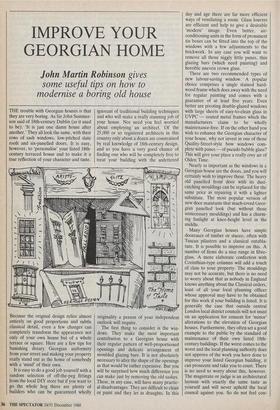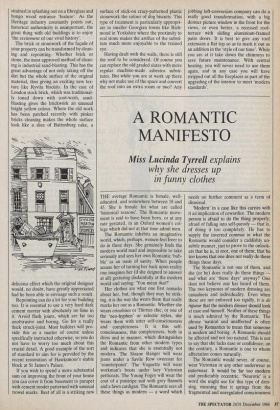IMPROVE YOUR GEORGIAN HOME
John Martin Robinson gives
some useful tips on how to modernise a boring old house
THE trouble with Georgian houses is that they are very boring. As Sir John Summer- son said of 18th-century Dublin (as it used to be): 'It is just one damn house after another.' They all look the same, with their rows of sash windows, low-pitched slate roofs and six-panelled doors. It is easy, however, to 'personalise' your listed 18th- century terraced house and to make it a true reflection of your character and taste.
Because the original design relies almost entirely on good proportions and subtle classical detail, even a few changes can completely transform the appearance not only of your own house but of a whole terrace or square. Here are a few tips for banishing dreary Georgian uniformity from your street and making your property really stand out as the home of somebody with a 'mind' of their own.
It is easy to do a good job yourself with a random selection of off-the-peg fittings from the local DIY store but if you want to go the whole hog there are plenty of builders who can be guaranteed wholly ignorant of traditional building techniques and who will make a really stunning job of your house. Nor need you feel worried about employing an architect. Of the 25,000 or so registered architects in this country only about a dozen are constrained by real knowledge of 18th-century design, and so you have a very good chance of finding one who will be completely free to treat your building with the unfettered originality a person of your independent outlook will require.
The first thing to consider is the win- dows. They make the most important contribution to a Georgian house with their regular pattern of well-proportioned openings and delicate arrangement of moulded glazing bars. It is not absolutely necessary to alter the shape of the openings as that would be rather expensive. But you will be surprised how much difference you can make just by removing the old sashes. These, in any case, will have many practic- al disadvantages. They are difficult to clean or paint and they let in draughts. In this day and age there are far more efficient ways of ventilating a room. Glass louvres are efficient and help to give a desirable 'modern' image. Even better, air- conditioning units in the form of prominent tin boxes can be fitted into the top of the windows with a few adjustments to the brickwork. In any case you will want to remove all those niggly little panes, thin glazing bars (which need painting) and horrible uneven crown glass.
There are two recommended types of new labour-saving window. A popular choice comprises a single stained hard- wood frame which does away with the need for regular painting and comes with a guarantee of at least five years. Even better are pivoting double-glazed windows with large sheets of easy-to-clean glass in UVPC — coated metal frames which the manufacturers claim to be wholly maintenance-free. If on the other hand you wish to enhance the Georgian character of your house, why not invest in one of those Quality-Street-style bow windows com- plete with panes — of pseudo bubble glass? This will give your place a really cosy air of Olden Time.
Nearly as important as the windows in a Georgian house are the doors, and you will certainly wish to improve these. The heavy old panelled front door with its dust- catching mouldings can be replaced for the same price as repairing it with a lighter substitute. The most popular version of new door maintains that much-loved Cieor- gian panelled look (but without those unnecessary mouldings) and has a charm- ing fanlight at knee-height level in the middle.
Many Georgian houses have simple doorcases of timber or stucco, often with Tuscan pilasters and a classical entabla- ture. It is possible to improve on this. A number of firms do a nice range in fibre- glass. A more elaborate confection with Corinthian-type columns will add a touch of class to your property. The mouldings may not be accurate, but there is no need to worry about that as nobody in England knows anything about the Classical orders, least of all your local planning officer whose approval may have to be obtained for this work if your building is listed. It is generally the case that outside central London local district councils will not insist on an application for consent for 'minor' alterations to the elevation of Georgian houses. Furthermore, they often set a good example to the public by the standard of maintenance of their own listed 18th- century buildings. If the worst comes to the worst and the local planning authority does not approve of the work you have done to improve your listed Georgian building, it can prosecute and take you to court. There is no need to worry about this, however. The magistrate or judge is an architectural layman with exactly the same taste as yourself and will never uphold the local council against you. So do not feel con- strained in splashing out on a fibreglass and bongo wood entrance 'feature'. As the Heritage industry constantly points out, historical authenticity is unimportant, the great thing with old buildings is to enjoy 'the excitement of our vivid history'.
The brick or stonework of the façade of your property can be transformed by clean- ing and repointing. Whether brick or stone, the most approved method of clean- ing is industrial sand-blasting. This has the great advantage of not only taking off the dirt but the whole surface of the original material, thus giving an exciting new tex- ture like Ryvita biscuits. In the case of London stock brick, which was traditional- ly toned down with soot-wash, sand- blasting gives the brickwork an unusual bright yellow colour. Where the old work has been patched recently with pinker bricks cleaning makes the whole surface look like a slice of Battenburg cake, a delicious effect which the original designer would, no doubt, have greatly appreciated had he been able to envisage such a result.
Repointing can do a lot for your building too. It is essential to use a very hard dark cement mortar with absolutely no lime in it. Avoid flush joints, which are far too unobtrusive and boring. Go for a really thick struck-joint. Most builders will pro- vide this as a matter of course unless specifically instructed otherwise, so you do not have to worry too much about this crucial detail. A good example of the sort of standard to aim for is provided by the recent restoration of Hawksmoor's stable block at St James's Palace.
If you wish to spend a more substantial sum on improving the front of your house you can cover it from basement to parapet with cement render patterned with unusual trowel marks. Best of all is a striking new surface of stick-on crazy-patterned plastic stonework the colour of dog biscuits. This type of treatment is particularly appropri- ate in smaller Georgian towns like Rich- mond in Yorkshire where the proximity to real stone makes the artifice of the substi- tute much more enjoyable to the trained eye.
Having dealt with the walls, there is still the roof to be considered. Of course you can replace the old graded slates with more regular machine-made asbestos substi- tutes. But while you are at work up there why not make use of the space and convert the roof into an extra room or two? Any jobbing loft-conversion company can do a really good transformation, with a big dormer picture window in the front for the views, or even better, a recessed roof- terrace with sliding aluminium-framed patio doors. It is best to give any roof extension a flat top so as to mark it out as an addition in the 'style of our time'. While you are at it take down the chimneys to save future maintenance. With central heating, you will never need to use them again, and in any case you will have stripped out all the fireplaces as part of the upgrading of the interior to meet 'modem standards'.











































































































 Previous page
Previous page